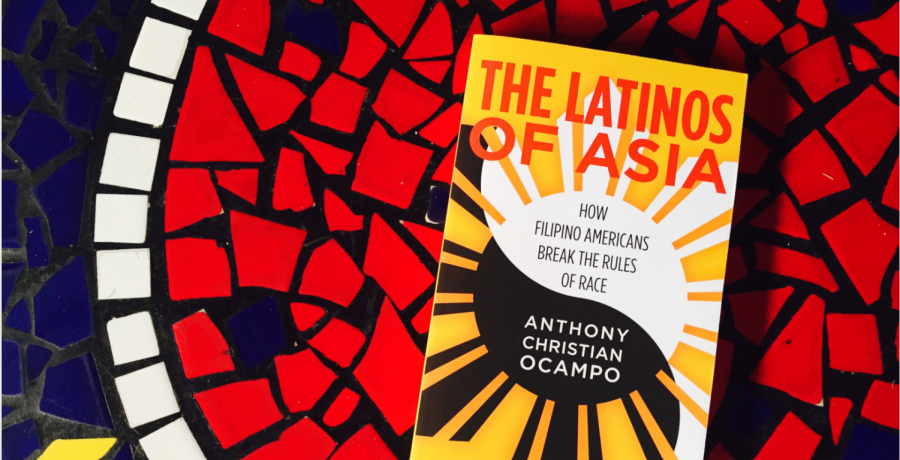Author discusses the Filipinx identity
Dr. Anthony Ocampo is the author of “The Latinos of Asia.”
Students came out to spend an evening with Dr. Anthony Ocampo to discuss the struggle of Filipinix identity at The Latinos of Asia on Oct. 10.The Cross-Cultural Center, who hosted the event in collaboration with the Latin@ Center and USU Live!, first introduced Dr. Ocampo.
Dr. Ocampo, an associate professor of sociology at CSU Poly-Tech Ramona, is a writer who focuses on issues of immigration, race, ethnicity, gender and sexuality. He is also the author of The Latinos of Asia: How Filipino Americans Break the Rules of Race. His lecture on The Latinos of Asia was based off of the research that he conducted for his book as well as his personal experiences as a Filipinx American.
Dr. Ocampo began his lecture by talking about his journey writing his first book, The Latinos of Asia.
After leaving his small Filipinx community to attend a predominantly white college, Dr. Ocampo recalled how he felt alone and faced a culture shock.
“I felt like I didn’t belong, I felt like I wasn’t smart enough. In part, because… I felt like the classmates I lived with in my dorm didn’t really understand what I was saying,” Dr. Ocampo said, “It was my instinct to drop out of college, or at least transfer somewhere else.”
After taking Asian-American studies and other cultural studies classes, he said that things began to turn around for him and eventually began writing. He mentioned how his Filipino Studies professor really impacted him and inspired him to pursue a Ph.D.
“Having a Ph.D. means that you can build a career out of listening to Filipino American stories, researching Filipino American stories and eventually writing Filipino American stories. My mission ever since I took that class is to write a book that Filipino kids should be able to read in college,” said Dr. Ocampo.
At one point during his lecture, he asked students to guess how many Filipinix people were in America. Some students guessed 10 thousand and 120 thousand. Dr. Ocampo eventually revealed that there are 3.5 million Filipinx people in the United States, making Filipinx Americans the second largest Asian American population in the country.
Dr. Ocampo continued by saying that when people think about Asians and Asian Americans, they think mostly about East Asians and don’t really consider Southeast Asians, such as Filipinx people.
He also mentioned how at times, he wasn’t regarded as Asian and was even excluded from participating in a study for not being the right kind of Asian.
“There were moments where I was made not to feel Asian American,” said Dr. Ocampo.
Reading a brief excerpt from his book, from chapter The Puzzling Case of Asian Americans, he discussed the incident of when he was denied to be able to participate in paid alcohol study at UCLA during the time he was studying for his Ph.D.
Dr. Ocampo read aloud that, “Before I hung up the phone, I mentioned that I was Filipino and that’s when everything went downhill. ‘I am so sorry, but you are not eligible for the study’ the coordinator said.” The study only called for East Asian participants, not considering Filipinx as Asian.
In a slide, Dr. Ocampo showed that based off of his studies, 95 percent of Chinese, Vietnamese and Korean Americans had no problem identifying as Asian American, while only 45 percent of Filipinx identified as Asian American.
He talked about how one of his students called Filipinos the Mexicans of Asia, referring to the history of Spanish colonization in both the Philippines and Mexico. Dr. Ocampo discussed how Filipinx and Latinx people share many similarities, including phenotype, language, relationships and social networks.
“The majority of Filipinos identify as Roman Catholic, Filipinos have Spanish last names, like Cruz, Rodriguez, Torres,” said Dr. Ocampo.
Dr. Ocampo also showed a slide with the similarities in language that Spanish and Tagalog have, including words such as mesa, which means table in both Spanish and Tagalog.
He concluded his lecture by saying, “Everybody [Filipinix people] has a story in which they had interactional moments with people that are of Latinx descent, where they felt like there was a level of sameness that they couldn’t really put words to or couldn’t really explain.”
After the lecture, students had a chance to ask Dr. Ocampo questions. Then, students were shown a quick video based on Dr. Ocampo’s upcoming second book, Brown & Gay in LA: When Immigrant Dreams Meet Queer Realities.


